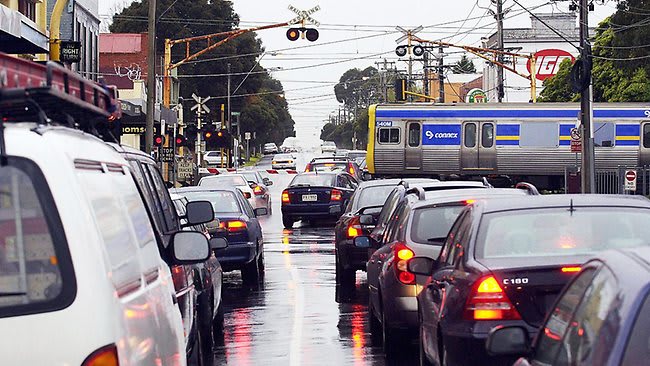Separation Anxiety - Why don't we remove more level crossings?
When it comes to transport election promises, we can always expect the usual suspects: more trains, new trains, extended lines and extra levels on the dumb ways to die app. And whilst the headlines have been dominated by the Melbourne Metro and an airport link, and more recently, cheaper fares, this impending Victorian election has thrown up a new poster child - the grade separation (or to the non-gunzels out there, level crossing removals).
Both sides of politics have fallen over themselves to make promises containing the new buzzword, bandying it about with gay abandon like it was created by Miley Cyrus whilst twerking on yet another clichéd music video awards night show.
So this begs the question - are they worth the hype? Do they really make that much difference?
There are over 1,800 level crossings in Victoria, with about 200 of those in Melbourne. Sydney has 5. That's not a typo - you can honestly count them on one hand. New South Wales decided to get rid of theirs in the 50s and 60s; we decided to build the Gas and Fuel towers and the Total Car Park. Score!
Several accidents, derailments and sadly, deaths later, we are finally seeing the light and following suit, albeit half a century too late. Given the rapidly inflating cost of building infrastructure, let alone retrofitting it, its an expensive mistake indeed.
This is not a new idea in Victoria. Back in 2008, the state government ranked every level crossing in the state, based on how dangerous they are, as well as traffic levels. Of the Top 10 in that priority list, 7 remain unchanged. This includes the notorious pair of Furlong Rd and Main Road, the site of several deaths over the years.
On the flipside, Louise Asher managed to get cash for the constituents of her safe Liberal seat to upgrade New St in Hampton, despite it being a lowly 223 on the list! So what was the point of this list if the real priority is just going to be determined by pork barreling and marginal seat sweeteners?
Grade separations are expensive - most coming in at over $100 million. Aside from the high cost of infrastructure, this is largely dictated by the method now most commonly used to do them. In the past this was achieved by building overpasses and underpasses. Not only are they visually ungainly, they often result in the removal of many houses/shops due to the length required of the structure.
Therefore the majority of today's urban level crossing removals are achieved by lowering a short section of the track below the level of the road. Not only is this expensive in itself, level crossings are often located adjacent to a station, thus requiring a total rebuild of said station to boot.
This expense has obviously made governments reluctant to cough up the cash. However with public transport coming more and more to the fore this upcoming election, and with our train system plagued by speed and capacity problems, our politicians are finally coming to the party.
Aside from providing something tangible to sell to voters, grade separations offer 3 main benefits:
- They save lives. Whilst on the surface they are essentially a transport issue, the fact that they will prevent deaths far outweighs any other benefits. Unfortunately, no amount of education, no amount of warnings, will prevent people from occasionally getting careless, or quite recklessly rolling the dice. The flow on effects are enormous; aside from the death of the victims, their families, witnesses to the accident and train drivers all can suffer enormous emotional damage. This alone should be enough justification to make it a priority.
- They make our train/tram/bus network more efficient. Trams and especially trains need to slow down considerably whilst travelling through level crossings. And heaven forbid if there is an accident - the whole line is closed for hours, if not days, whilst repairs are undertaken. Thanks to the current tightly coupled state of our train lines, network wide chaos usually ensures. Buses suffer terribly too. Already slaves to the surrounding traffic level, travel times are further blown out whilst they patiently wait for the red and white sticks of gloom to rise, thus metaphorically parting the red sea and leading to the promised land of the intended bus interchange terminus.
- They potentially reduce traffic congestion. Notice this sits last in the list of benefits, and more importantly, note the use of the word 'potentially'. Make no mistake, the net benefit from the previous point far outweighs any benefit to motorists in terms of the sheer number of people involved. Any benefit motorists gain should be treated as a bonus, and a temporary one at that. Just like the building of a new freeway, or the upgrade of an existing road, induced traffic will ensure that the traffic levels will soon return to their original levels.
This Herald Sun article (dated August 30th 2013) illustrates and reports quite succinctly on what happens when things go wrong at level crossings.
Whilst the Greens mention level crossings under "improved safety and fuel efficiency" in their transport policy document, we're yet to see anything like the policy announcements that both the Coalition and ALP have rolled recently. But one thing is quite clear regardless of the specific party positions: there's been a great deal of policy sharpening in this area, and that's a good thing.
The mind boggles at the level of improvement such a number of removals could provide. “Imagine a Melbourne without level crossings” sounds like an overly optimistic line from the John Lennon classic 'Imagine', but it is actually a reality we can achieve in the current political generation.
